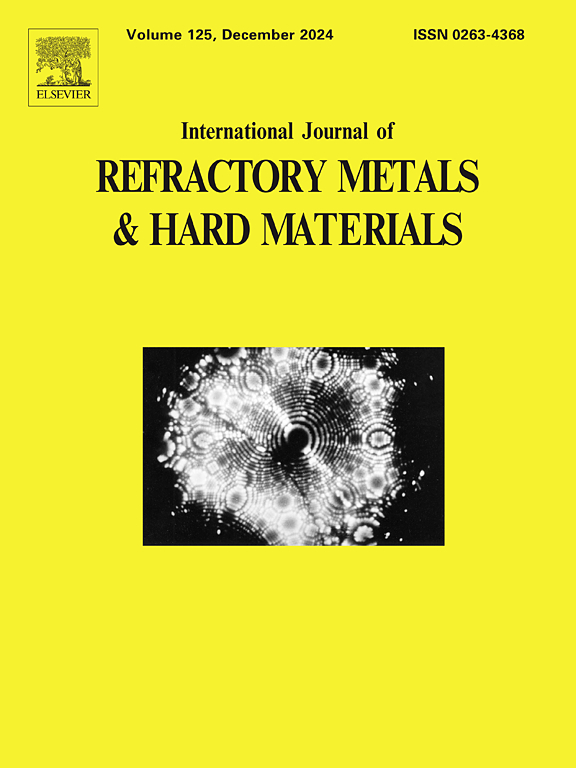Dislocation loops enhance wear resistance in Ti2Zr0.75NbVx lightweight refractory medium-entropy alloys via high thermal conductivity-promoted oxide film formation
IF 4.6
2区 材料科学
Q2 MATERIALS SCIENCE, MULTIDISCIPLINARY
International Journal of Refractory Metals & Hard Materials
Pub Date : 2025-05-22
DOI:10.1016/j.ijrmhm.2025.107239
引用次数: 0
Abstract
This study systematically investigates the friction and wear behavior of Ti2Zr0.75NbVx (x = 0.25, 0.5, 0.75, 1) lightweight refractory medium-entropy alloys (MEAs) and the underlying wear resistance enhancement mechanisms through a combined approach of experimental characterization and molecular dynamics (MD) simulations. The results reveal that atomic size mismatch-induced lattice distortion promotes the accumulation of residual stress, thereby facilitating the formation of dislocation loops. These dislocation loop structures significantly enhance the thermal conductivity of the material. The improved thermal conductivity accelerates the formation of dense oxide films by promoting oxygen diffusion and homogenizing the surface temperature field during friction. The oxide films effectively suppress stress concentration and plastic deformation, leading to a remarkable reduction in wear. Among the investigated alloys, the V0.5 composition exhibits the optimal wear resistance, with its dislocation loop structure not only substantially increasing the thermal conductivity (increasing from 32.4 W/(m·K) to 37.1 W/(m·K)) but also achieving the lowest average friction coefficient (0.6239) and wear rate (3.1181 × 10−4 mm3/N·m) compared to other compositions. This work provides important theoretical insights and experimental support for optimizing the wear resistance of lightweight refractory MEAs.

位错环通过高热导率促进氧化膜的形成提高了Ti2Zr0.75NbVx轻质难熔中熵合金的耐磨性
本研究通过实验表征和分子动力学模拟相结合的方法,系统地研究了Ti2Zr0.75NbVx (x = 0.25, 0.5, 0.75, 1)轻质耐火中熵合金(MEAs)的摩擦磨损行为和潜在的耐磨性增强机制。结果表明,原子尺寸不匹配引起的晶格畸变促进了残余应力的积累,从而促进了位错环的形成。这些位错环结构显著提高了材料的导热性。热导率的提高促进了摩擦过程中氧的扩散,使表面温度场均匀化,从而加速了致密氧化膜的形成。氧化膜有效地抑制应力集中和塑性变形,从而显著降低磨损。在所研究的合金中,V0.5具有最佳的耐磨性,其位错环结构不仅显著提高了导热系数(从32.4 W/(m·K)增加到37.1 W/(m·K)),而且平均摩擦系数(0.6239)和磨损率(3.1181 × 10−4 mm3/N·m)均低于其他成分。这项工作为优化轻质耐火mea的耐磨性提供了重要的理论见解和实验支持。
本文章由计算机程序翻译,如有差异,请以英文原文为准。
求助全文
约1分钟内获得全文
求助全文
来源期刊
CiteScore
7.00
自引率
13.90%
发文量
236
审稿时长
35 days
期刊介绍:
The International Journal of Refractory Metals and Hard Materials (IJRMHM) publishes original research articles concerned with all aspects of refractory metals and hard materials. Refractory metals are defined as metals with melting points higher than 1800 °C. These are tungsten, molybdenum, chromium, tantalum, niobium, hafnium, and rhenium, as well as many compounds and alloys based thereupon. Hard materials that are included in the scope of this journal are defined as materials with hardness values higher than 1000 kg/mm2, primarily intended for applications as manufacturing tools or wear resistant components in mechanical systems. Thus they encompass carbides, nitrides and borides of metals, and related compounds. A special focus of this journal is put on the family of hardmetals, which is also known as cemented tungsten carbide, and cermets which are based on titanium carbide and carbonitrides with or without a metal binder. Ceramics and superhard materials including diamond and cubic boron nitride may also be accepted provided the subject material is presented as hard materials as defined above.

 求助内容:
求助内容: 应助结果提醒方式:
应助结果提醒方式:


